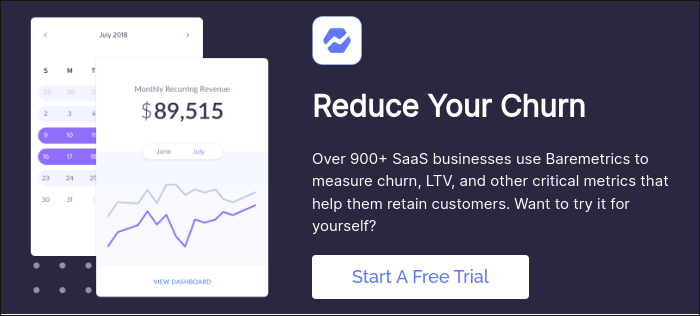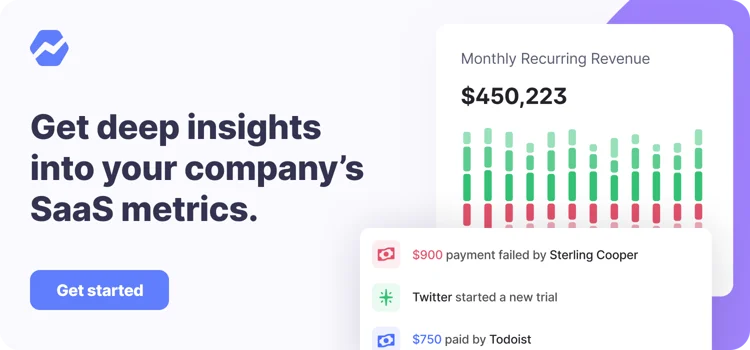Table of Contents
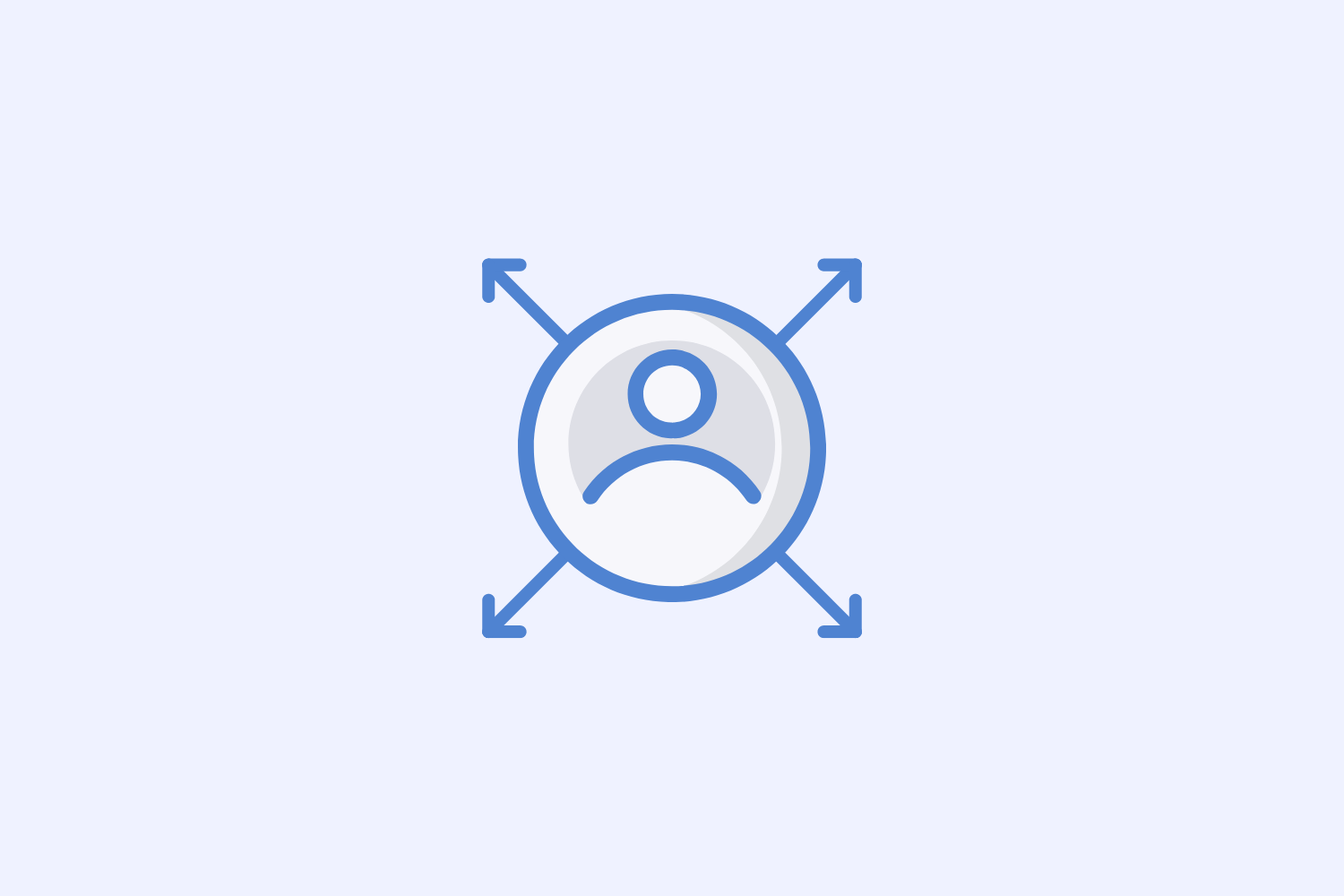
Think about the time, energy and resources you put towards acquiring new customers.
Now, how much time, energy and resources do you put towards increasing the revenue you get from your existing customers, a.k.a customer expansion?
If you’re like a lot of SaaS companies, chances are you’re fixated on customer acquisition. Most of your marketing dollars are probably spent on ads and content to get more people to sign up for your product. And you have salespeople dedicated to chasing down new leads.
As someone who’s spent most of my SaaS career focused on getting new customers, I get it.
But as I’ve seen throughout my time at Baremetrics, customer expansion is an extremely underrated growth strategy that SaaS companies take for granted.
As I dug more into our own data, and spoke to other SaaS companies, I started to learn more about the best ways to grow a business through customer expansion. And as always, I’m sharing everything I’ve learned with you.
In this guide, you’ll learn:
- The three types of customer expansion most SaaS companies use to grow (explained through ice cream!)
- The truth that nobody tells you about customer acquisition
- Five customer expansion strategies for growth (with real life examples and results)
Three types of customer expansion for growth
In most cases, customer expansion falls under one of three buckets for SaaS companies:
- Upgrade: Offering a better/higher priced version of your product
- Cross-sell: Offering a complementary product
- Add-ons: Offering additional functionality or features to improve your customer’s current subscription
Here’s a visual of the difference between the three, explained with ice cream!
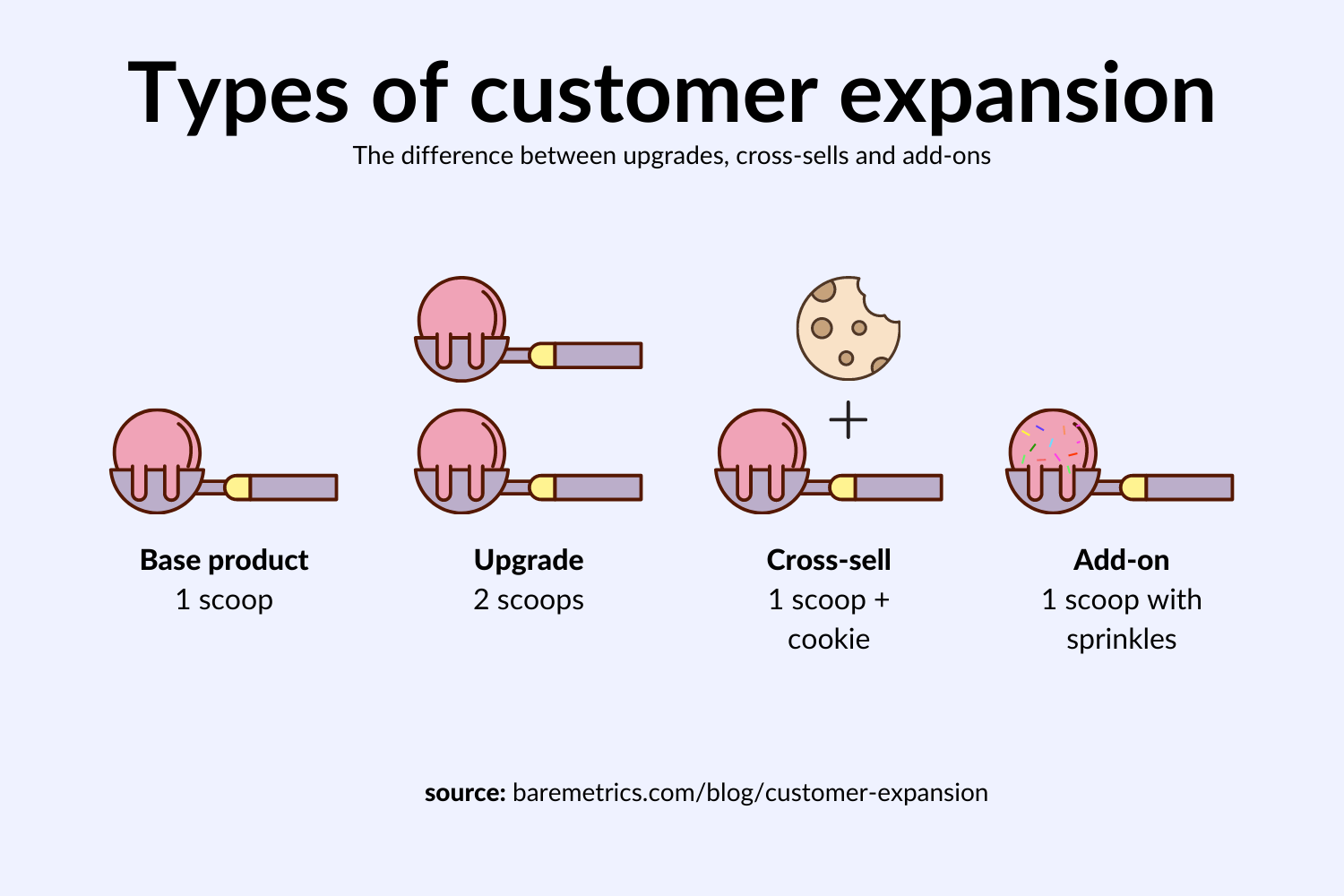
Ice cream is sweet (pun!), but let’s look at a few real-world examples of each type of customer expansion.
Customer expansion through upgrades
Later offers four different plans. On the Starter plan, users can post up to 60 posts on each of their social profiles. But if they want to post, say, 100 to each profile, they’d need to switch to a higher level plan.
That’s an example of customer expansion through upgrading.
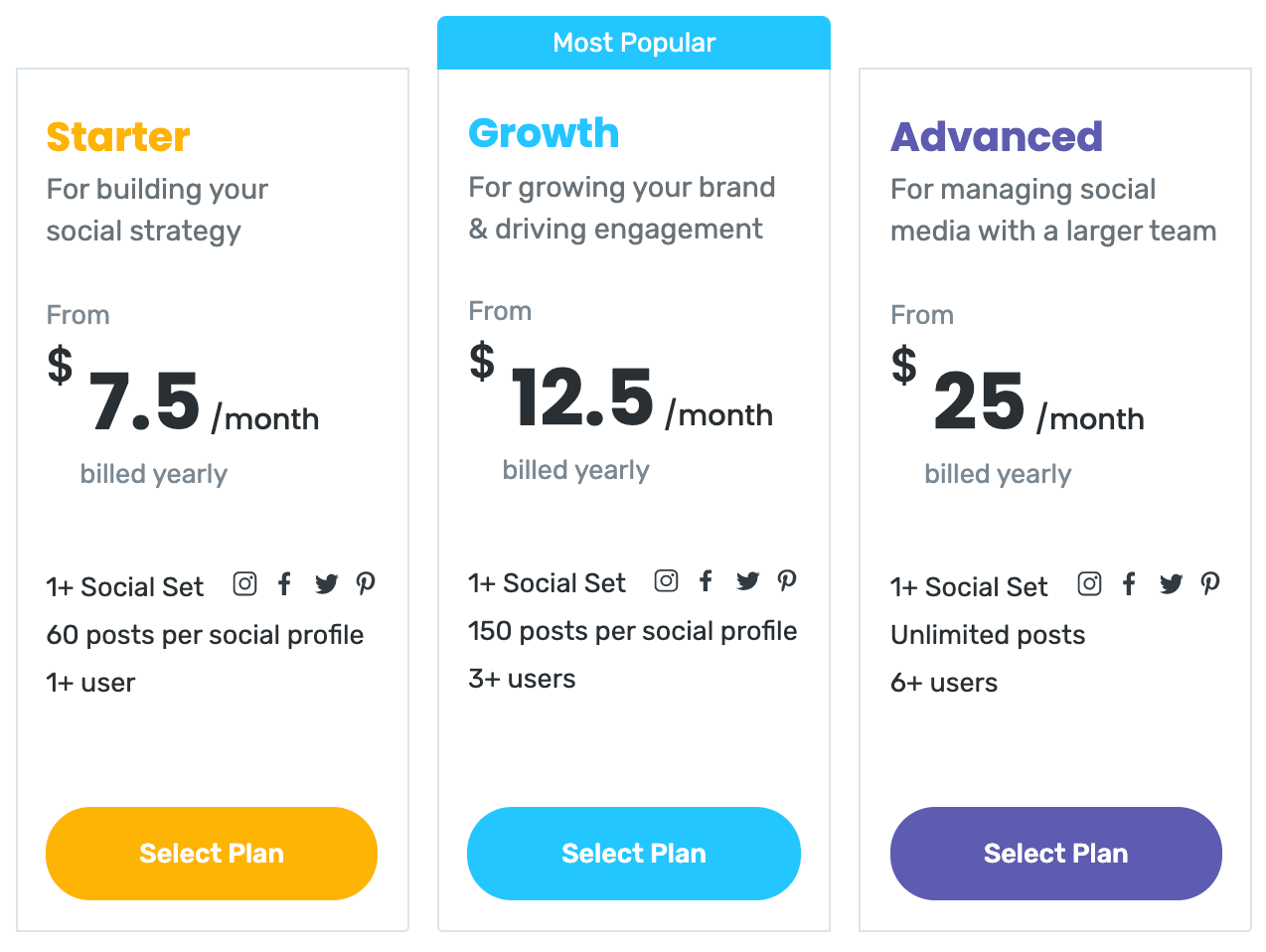
Customer expansion through cross-selling
At Baremetrics, our flagship product is our metrics. Detailed reporting and analytics on everything from revenue, churn, customers and more. But we also have a couple of other products as well, Cancellation Insights and Recover.
Each of these products enhance the value you get from our metrics, but you don’t necessarily need them to use Baremetrics. That’s an example of customer expansion through cross-selling.
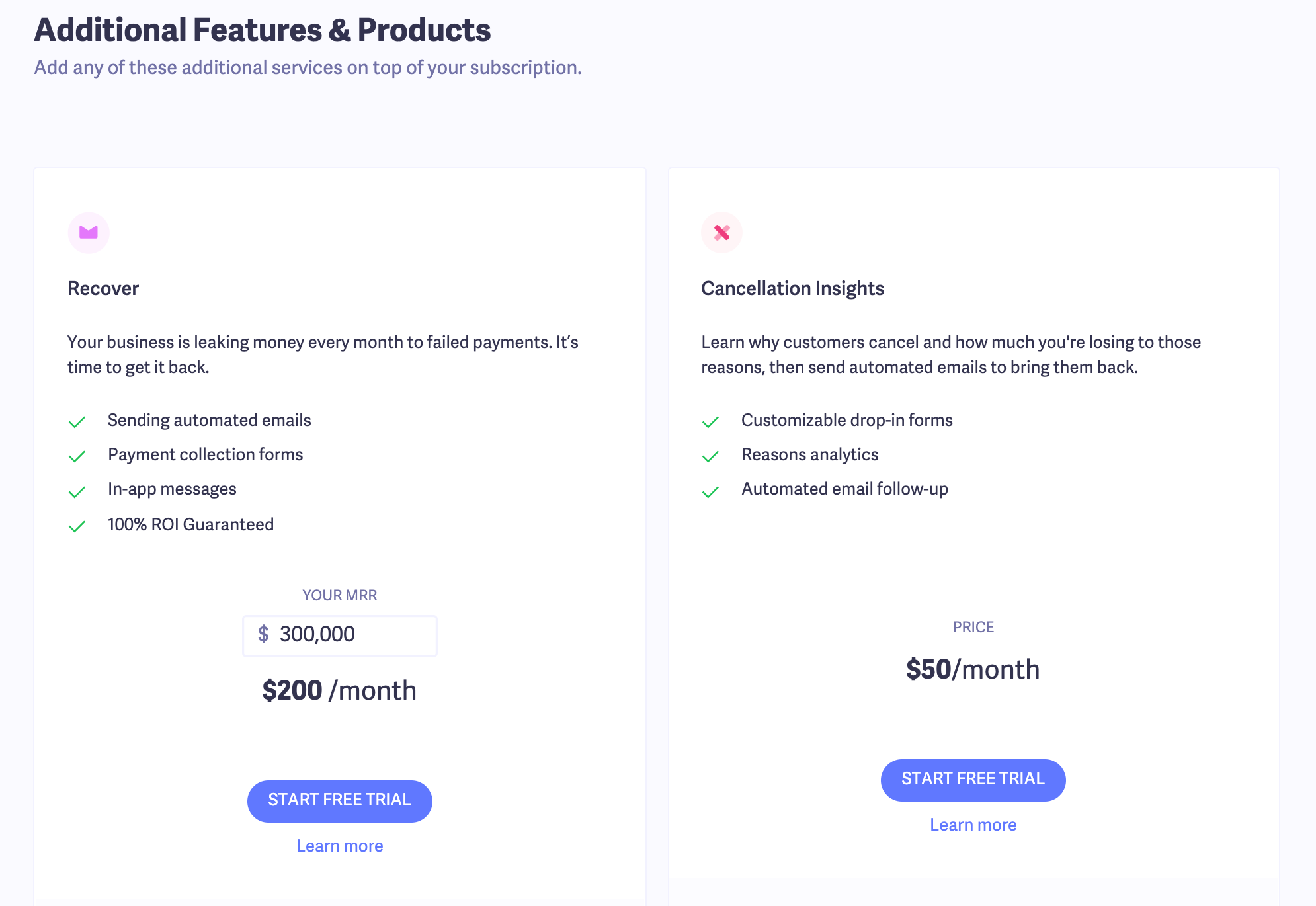
Customer expansion through add-ons
Ahrefs offers plans based on one user (for their two lowest priced plans). If you want to add an additional user to your plan, there’s an additional cost.
That’s an example of customer expansion through add-ons.

Customer expansion is hands down one of the best ways to grow a SaaS company without falling victim to the “acquire new customers at all costs” mindset.
Which brings me to my next point.
What nobody tells you about customer acquisition
Getting new customers isn’t a bad thing. You’re running a business after all, so getting more people to pay you money is always the goal.
The problem however, comes when you think that getting new customers is the only way to grow your business. Not only is that not true, but in some cases, getting new customers isn’t even the best growth strategy.
We’ve all heard that it costs more to acquire new customers than to sell to existing ones. But that’s amplified even more when it comes to SaaS.
Here’s a quick look at the average customer acquisition cost (CAC) by industry according to data from Propeller.
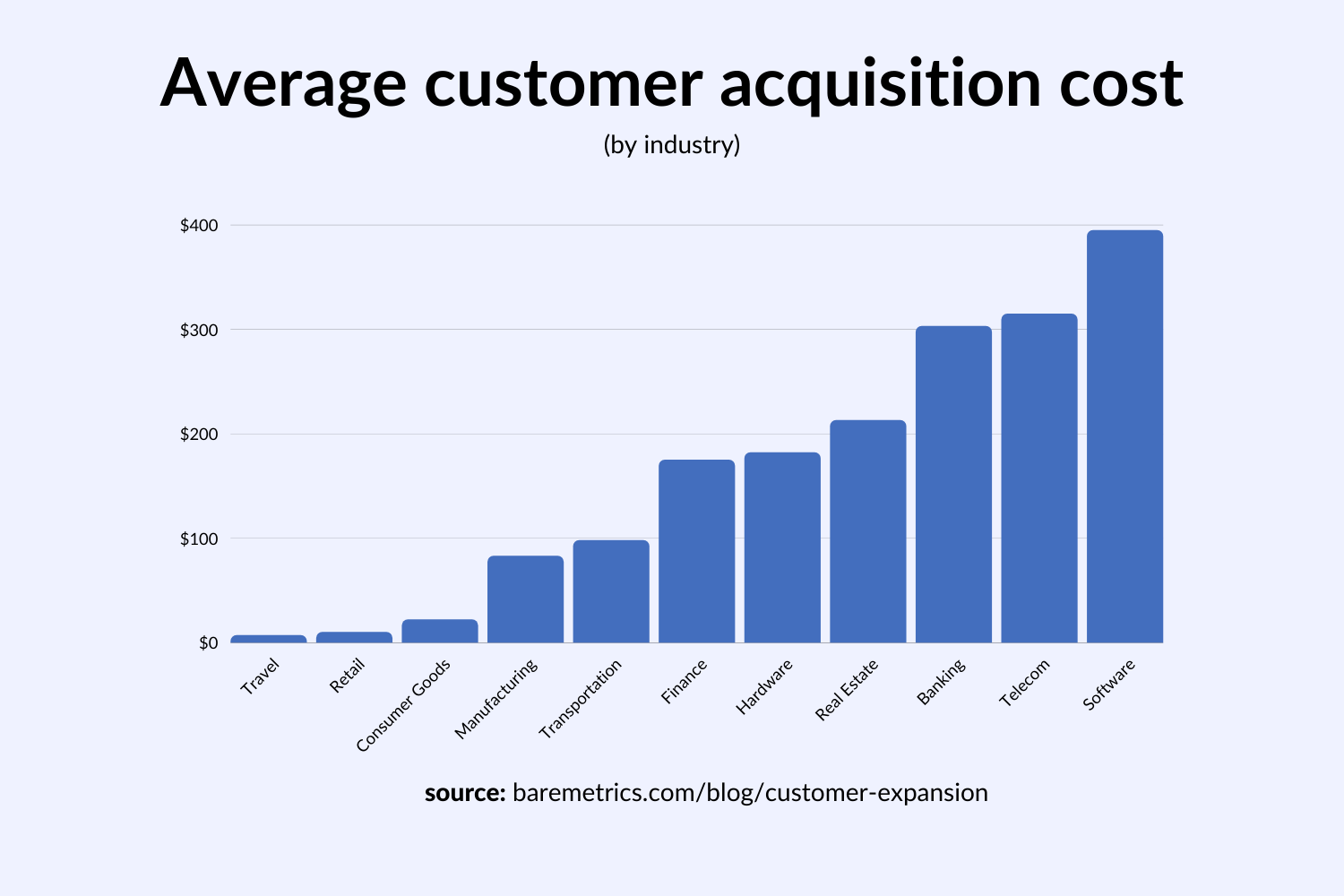
The software industry is at the top of the list.
But the cost of selling to your existing customers? It can be as low as zero, depending on how you do it, which we’ll talk about in the next section.
Beyond the cost, there’s also a lot more effort involved to acquire new customers. Here’s a simplified comparison of the amount of work you’d need to acquire a new customer, vs getting an existing customer to upgrade.
|
Selling to New vs. Existing Customers |
|
|---|---|
|
New customer |
Existing customer |
| Use marketing to get them to know you exist | Knows who you are |
| Get them to try your product (trial) | Already using your product |
| Convince them that your product is valuable | Knows exactly how your product benefits them |
| Convert them into a paid customer | Already paying you |
| Onboard them | They’ve already been onboarded |
In case you need any more convincing, we’ve personally experienced a ton of growth over the past 12 months thanks to our customer expansion efforts. In fact, there are plenty of months where our expansion MRR outperformed our MRR from new customers.

Get data like this for your company with Baremetrics
According to the co-founder of Encharge, Kalo Yankulov, half of their new MRR each month comes from customer expansion.
Kalo Yankulov
Co-Founder @ Encharge

Expansion revenue is a big part of our growth at Encharge. About half of the new MRR we add every month comes from expansion revenue. We have a value-based pricing model (based on the number of contacts in the system) and a naturally sticky product, so expansion revenue is not something we deliberately work towards. As customers grow, they experience more value with Encharge and move to higher tiers. We automatically upgrade accounts after they reach the contact threshold for the particular plan.
Encharge isn’t the only SaaS company growing from customer expansion. In the next section, I’ll show you five ways to boost your expansion revenue, with real-life stories of SaaS companies that have done it.
Five customer expansion strategies to skyrocket your growth
We went over the different types of customer expansion. But how do you put them to use? Just having an option to upgrade, or listing your add-on products on your website isn’t enough.
You need to be proactive about increasing your expansion MRR. Here’s how:
- Build customer expansion into your pricing model
- Send targeted emails to cross-sell or upgrade
- Show customers what they’re missing directly in your product
- Use customer feedback to create new products (and cross-sell them)
- Land and expand
1. Build customer expansion into your pricing model
Let’s start with what’s probably the most common paths towards customer expansion. Your pricing.
Value or usage-based pricing is when you charge based on usage, rather than having 3-4 flat rate pricing plans based on features. “Usage” can be defined by any number of things. For instance, Stripe’s pricing is based on a percentage of the charges they process.
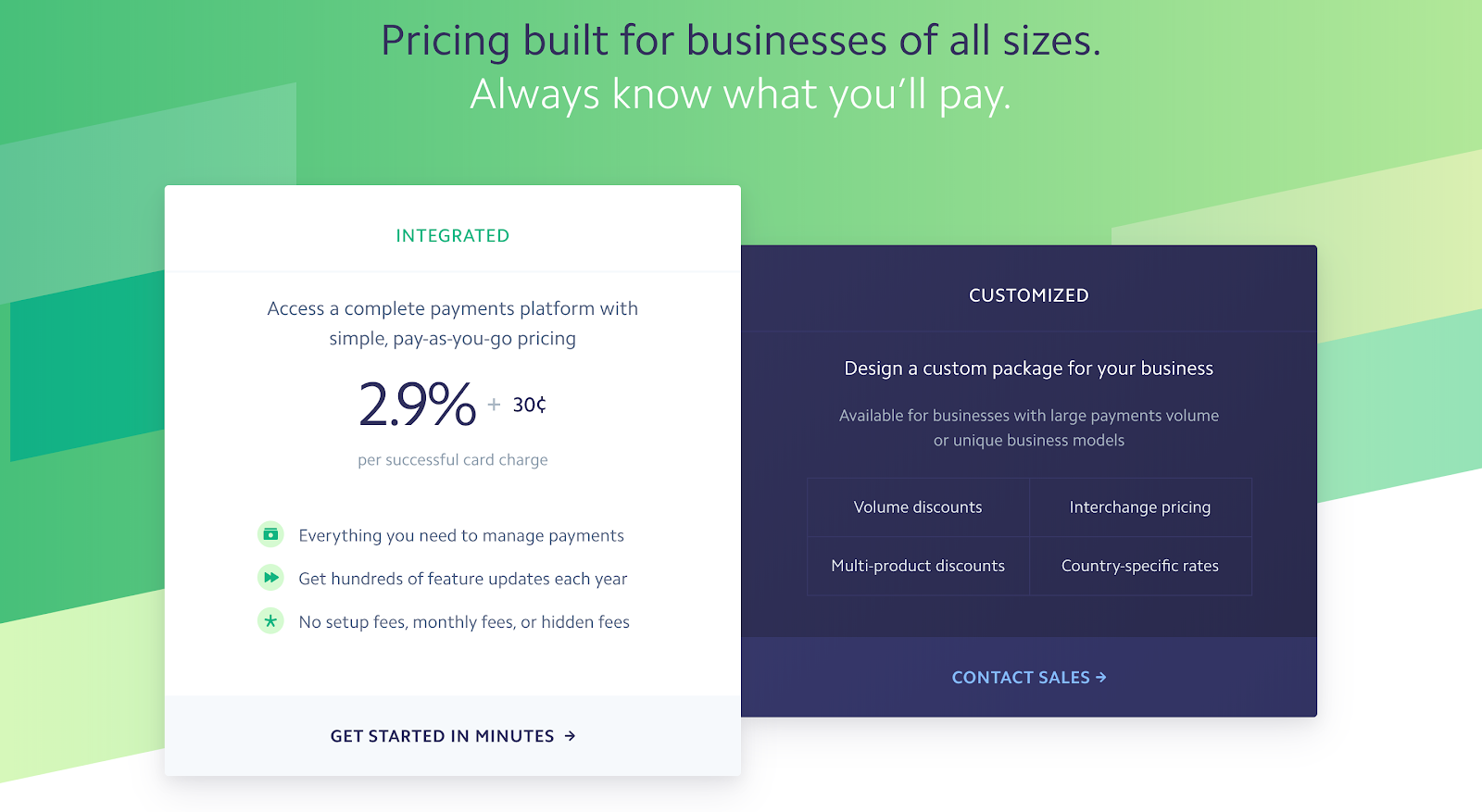
And at Baremetrics, we charge based on your MRR.

With a usage or value-based pricing model, customer expansion is baked right into your product. The more your customers use your product (or the more they grow), the more they pay. So even if you magically stopped gaining new customers, you could still grow your MRR from your existing customers.
Learn how to price your saas product
You see this pricing model used a lot by email marketing companies. They’ll generally price based on the number of email subscribers you have or the number of emails you send per month.
A great example of this is EmailOctopus. Their pricing is based on the number of email subscribers you have.

According to their Marketing Manager, Hollie Youlden, customer expansions accounted for 47% of new revenue and 9.48% of their MRR last month!
Since their pricing is usage based, the expansion happens almost automatically.
Hollie Youlden
Marketing Manager @ EmailOctopus

A user with 20,000 subscribers can send 200,000 emails a month as part of their plan. But if they send email campaigns more frequently and need to send more than 200,000 emails, they’ll be bumped up to the next price tier
This approach isn’t just for email marketing software though. The store locator app StoreRocket takes a similar approach. As their customers have more store locations to manage, they need to upgrade to a higher priced plan.
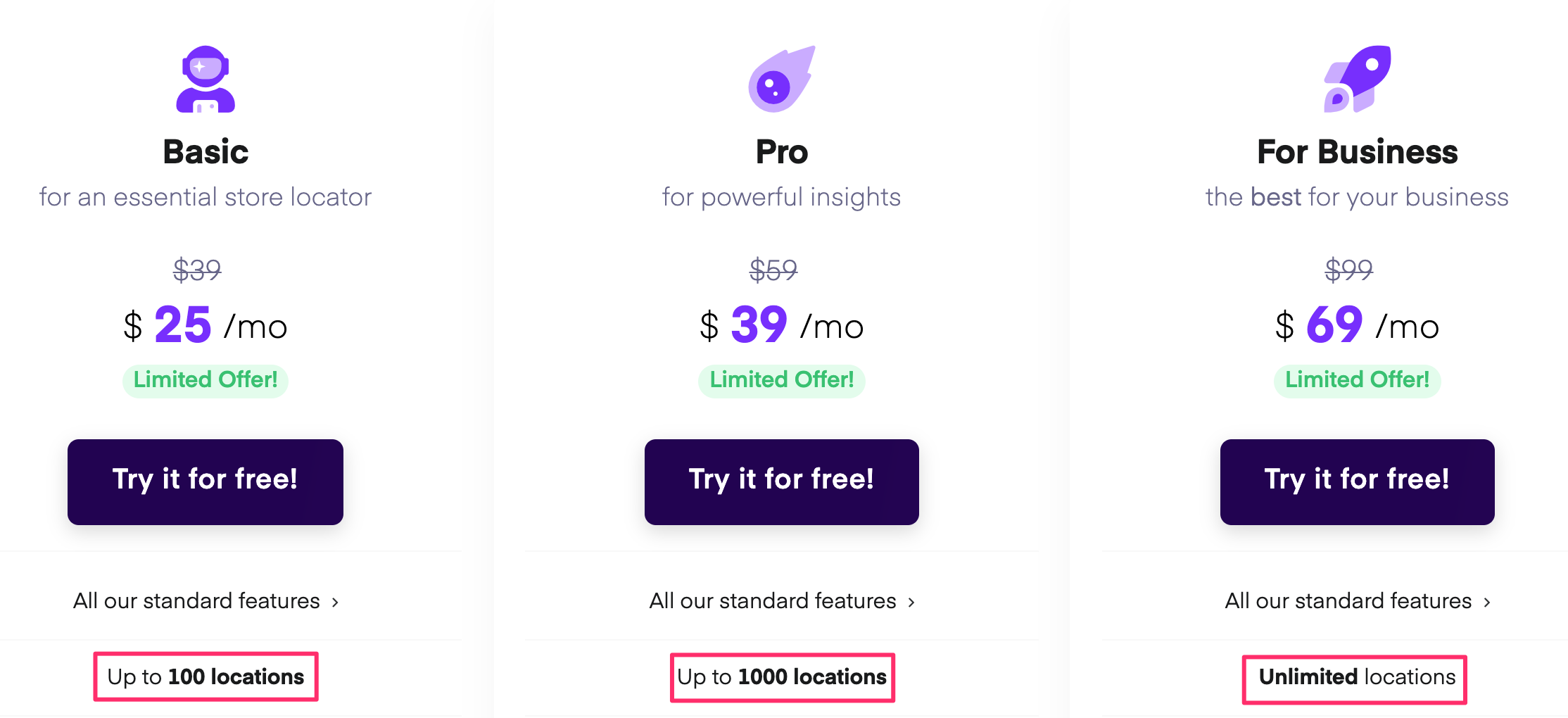
When a customer reaches the location limit for their current plan, StoreRocket sends an email asking them to upgrade their account.

Custify is another example. When customers go over their limit of users on their account, Custify sends emails to talk about upgrading their account instead of automatically charging them.
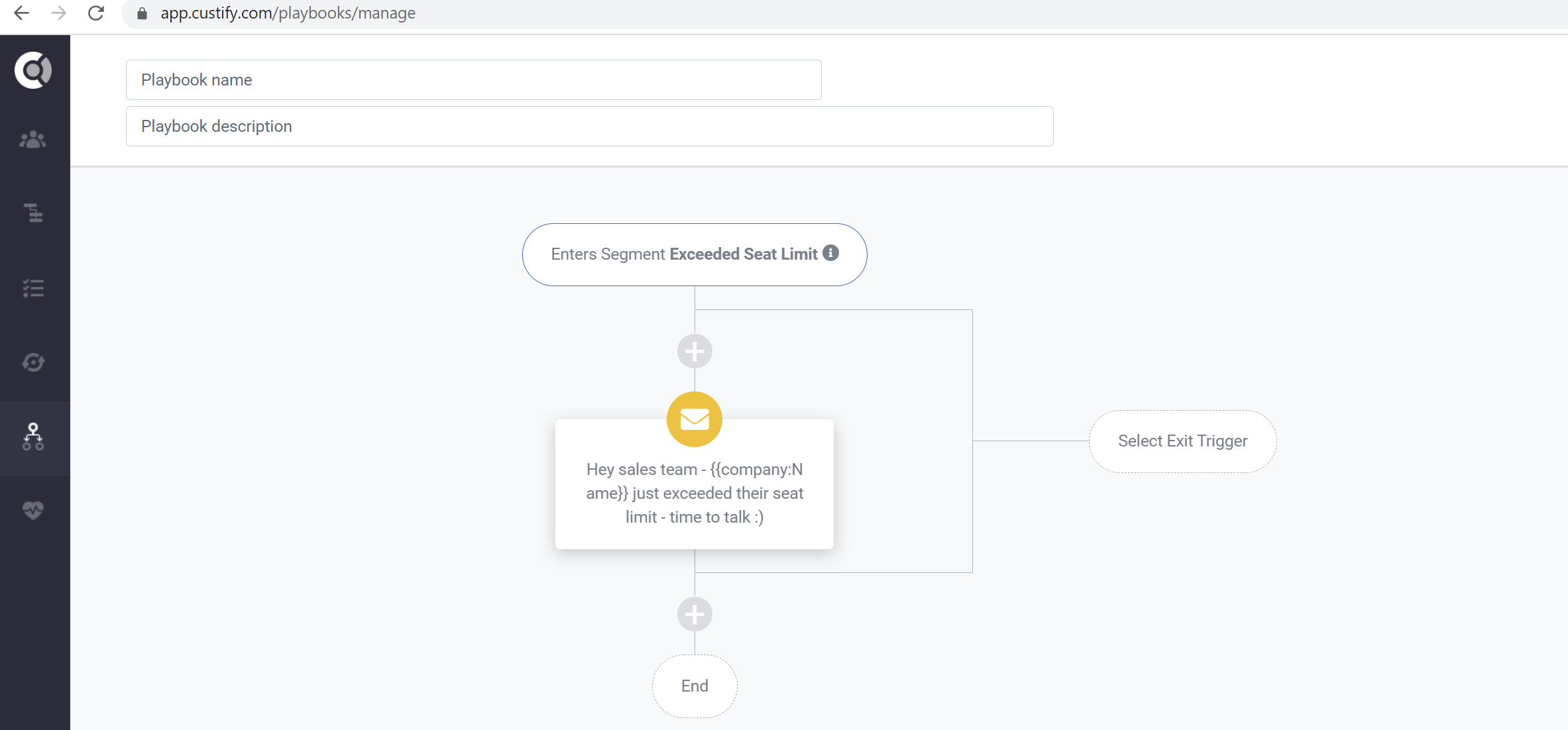
With this strategy, they’ve been able to convert over 70% of customers to their additional seat prices over the past 12 months.
One of the reasons I love this customer expansion approach is because it requires your product to deliver.
Going back to EmailOctopus, if their product wasn’t helping their customers to grow their email marketing efforts, their lists wouldn’t grow and therefore EmailOctopus wouldn’t get as much expansion MRR.
And in order to help customers grow, they also give them tips, templates and other resources to educate them on how to improve their email marketing.
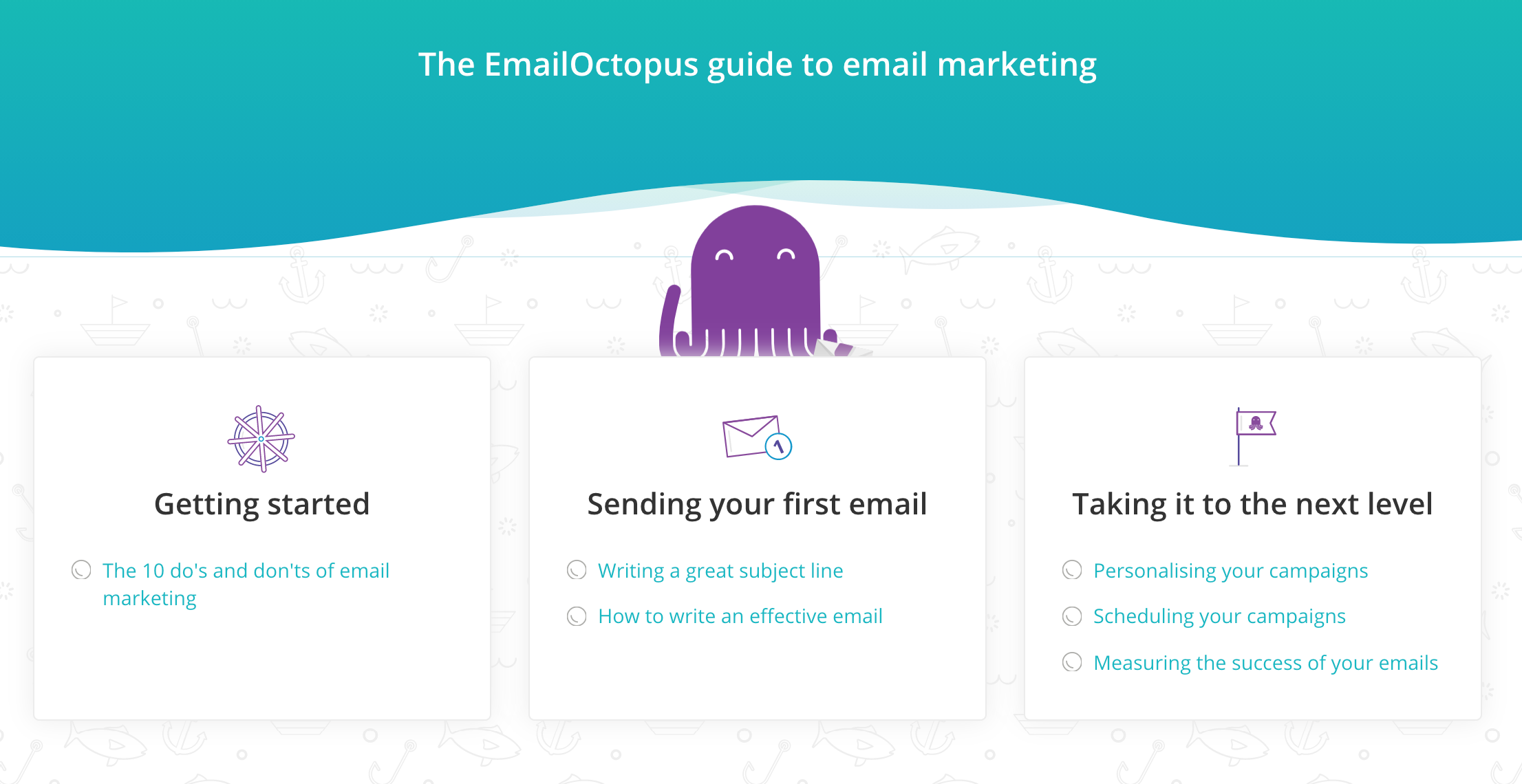
We take a similar approach at Baremetrics. In order for us to increase our expansion MRR, our customers need to grow.
So we’ve started to focus our efforts on creating content that shows SaaS companies how to grow their business (like this blog post!).
This strategy might not work for every business. But it’s a convenient way to somewhat automate your customer expansion.
2. Send targeted emails to cross-sell or upgrade
If you have multiple pricing plans or addons and upsells, email is going to be your best friend for customer expansion.
A lot of times, the only time SaaS companies send “sales” emails is when they’re cold emailing a new lead, or trying to convert free users to a paid plan. But who says you can’t sell to your existing customers over email too?
Here’s an example of an email from Buffer to cross-sell their Analytics tool.
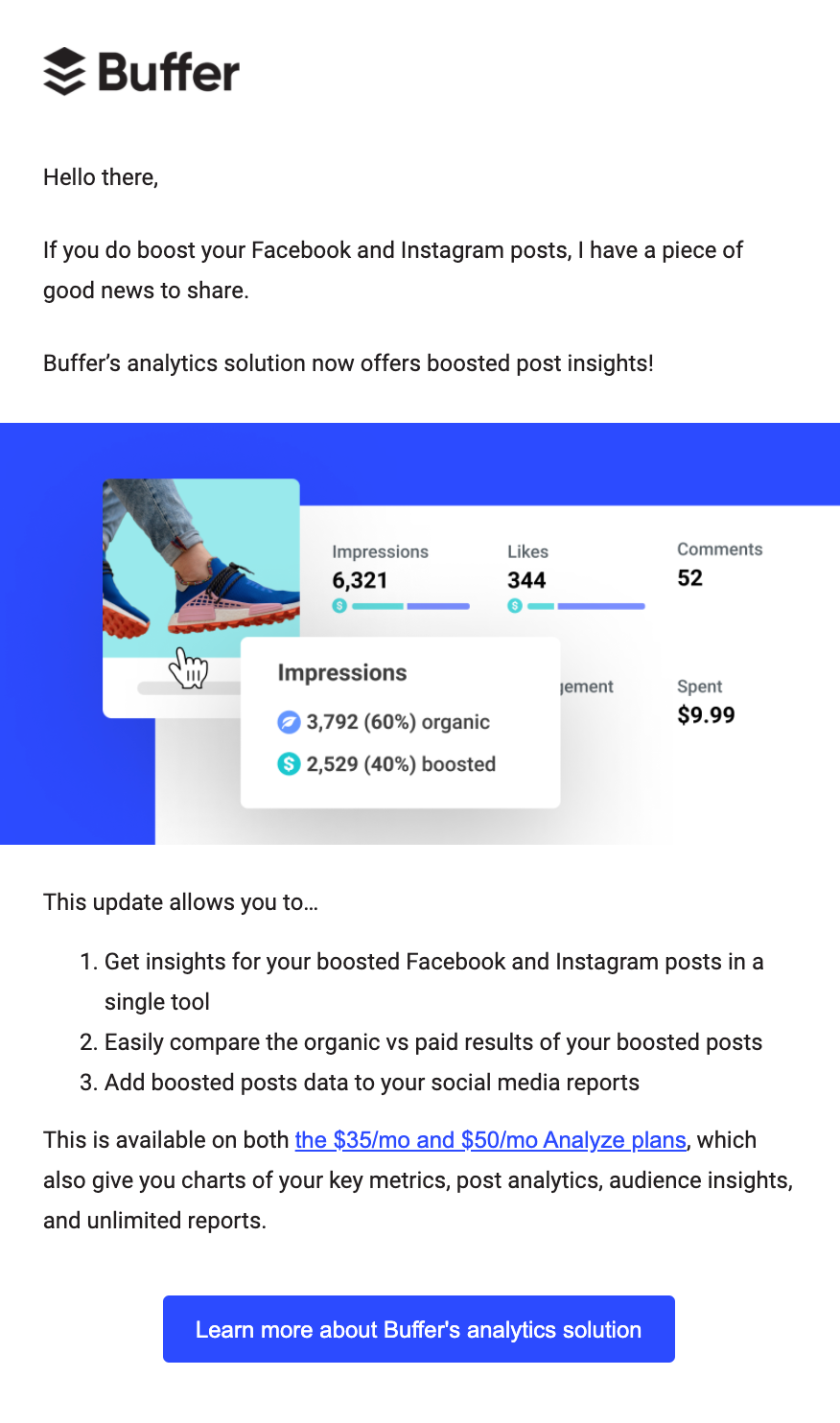
And here’s one from Sprout Social, also cross-selling premium analytics.
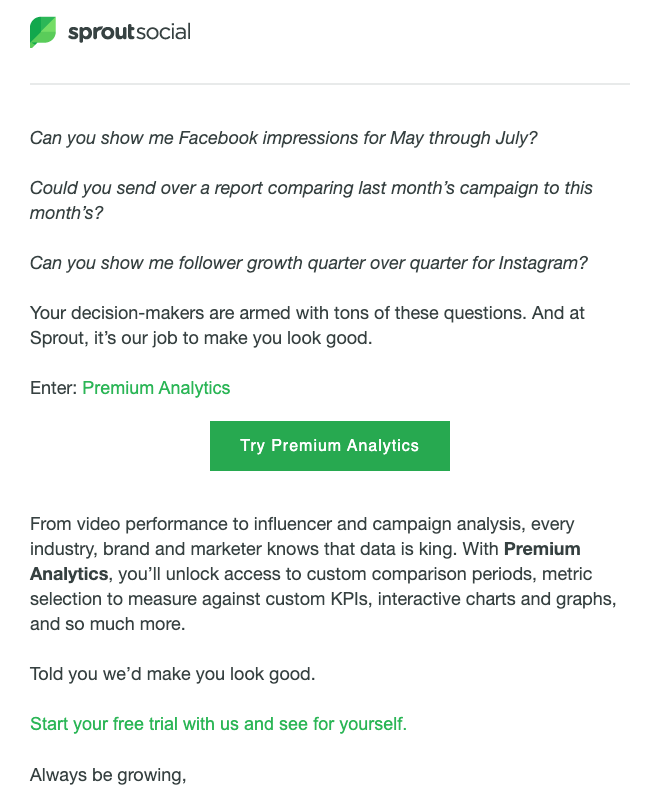
Let’s dig into what makes these emails effective, and how you can use email for your own customer expansion.
First, both of these emails were specifically sent to customers, as noted by the “Sent from” address in Sprout’s email.

If they were to send these emails to people who don’t currently use their product, the emails would:
- Lack context
- Come on way too strong
But since I’m already a customer of each, they have a bit more flexibility in the copy.
Next, let’s take a look at the subject lines they used. Sprout’s was very effective at getting me to open it up:
![]()
The reason this email is enticing, is because Sprout regularly sends out reports to customers. So your first thought when you see the subject line is that they’ve created some type of new report for you.
Here’s Buffer’s subject line.
![]()
They ask a question. As we’ve mentioned in some of our other posts about SaaS emails, questions are a great way to boost your open rate.
Plus, the answer to the question immediately qualifies the recipient. If they do use boosted posts, they’re likely to click on it. And even if you don’t use boosted posts, you might click on it just out of curiosity like I did.
In the body of each email, they get into specifics, without getting too in-depth. And if you’re interested, you click through to landing pages of each product.
This is actually a missed opportunity by both companies in my opinion. Instead of pointing to a generic landing page, they could’ve directed you to a page that shows your current plan + what you’d get by trying the new products.
That’s exactly what WhatConverts does. When customers contact their support team to ask about features that are only available on their premium plan, they send them a quick one-sheeter that outlines the value they’d get by upgrading.

A comparison chart like this makes it easier for customers to see what they’re missing out on and what they’ll get when they upgrade.
3. Show customers what they’re missing directly in your product
A good time to prompt customers to upgrade or upsell them is when they’re already signed in and using your product.
If you offer multiple plans, and the higher tier plans have additional features, make those features visible for users in lower tier plans—but lock them.
For instance, in ConvertKit, you can get Deliverability reports with their Creator Pro plan. Instead of completely hiding that feature for customers on lower plans, they make it visible and prompt you to upgrade in order to access the data.

Ahrefs uses an interactive widget to offer upgrades of their rank tracking tool.

If you’re going to push up-sells within your product, just be careful not to make them annoying and disruptive. They shouldn’t take away from your user’s experience.
It’s something we were cognizant of when we implemented our own in-product upsells. Here’s an example of how we up-sell our add-on products in our dashboards.
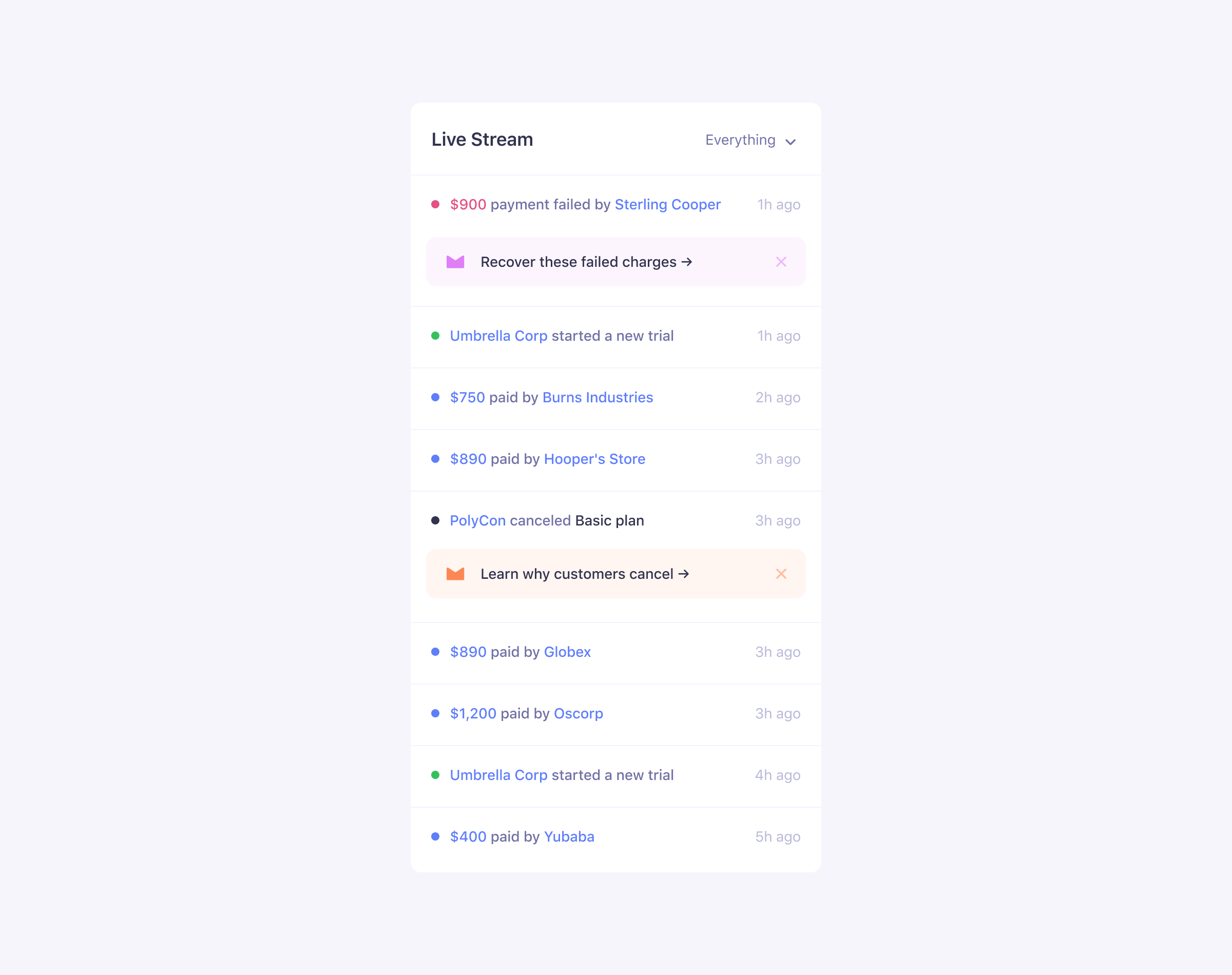
And we’ve gotten some good feedback on our approach!

The more contextual and relevant you can make your in-product upsells, the better.
Soapbox is another company that prompts users to update their plan in-app, and according to their CEO, Brennan McEachran, it plays a big role in their customer expansion.
Brennan McEachran
CEO @ Soapbox

We follow a product-led growth approach, meaning that we let the product do the activating, talking, selling, you name it (for the most part). Most of our sales are done completely self-serve (people upgrade themselves) and most expansions happen naturally as users add more people to their Soapbox community. With a PLG model, we also rely on tripwires within the app to flag to users that they need to upgrade to use a specific feature.

That’s accompanied with a way to upgrade immediately within the app through a payment modal.
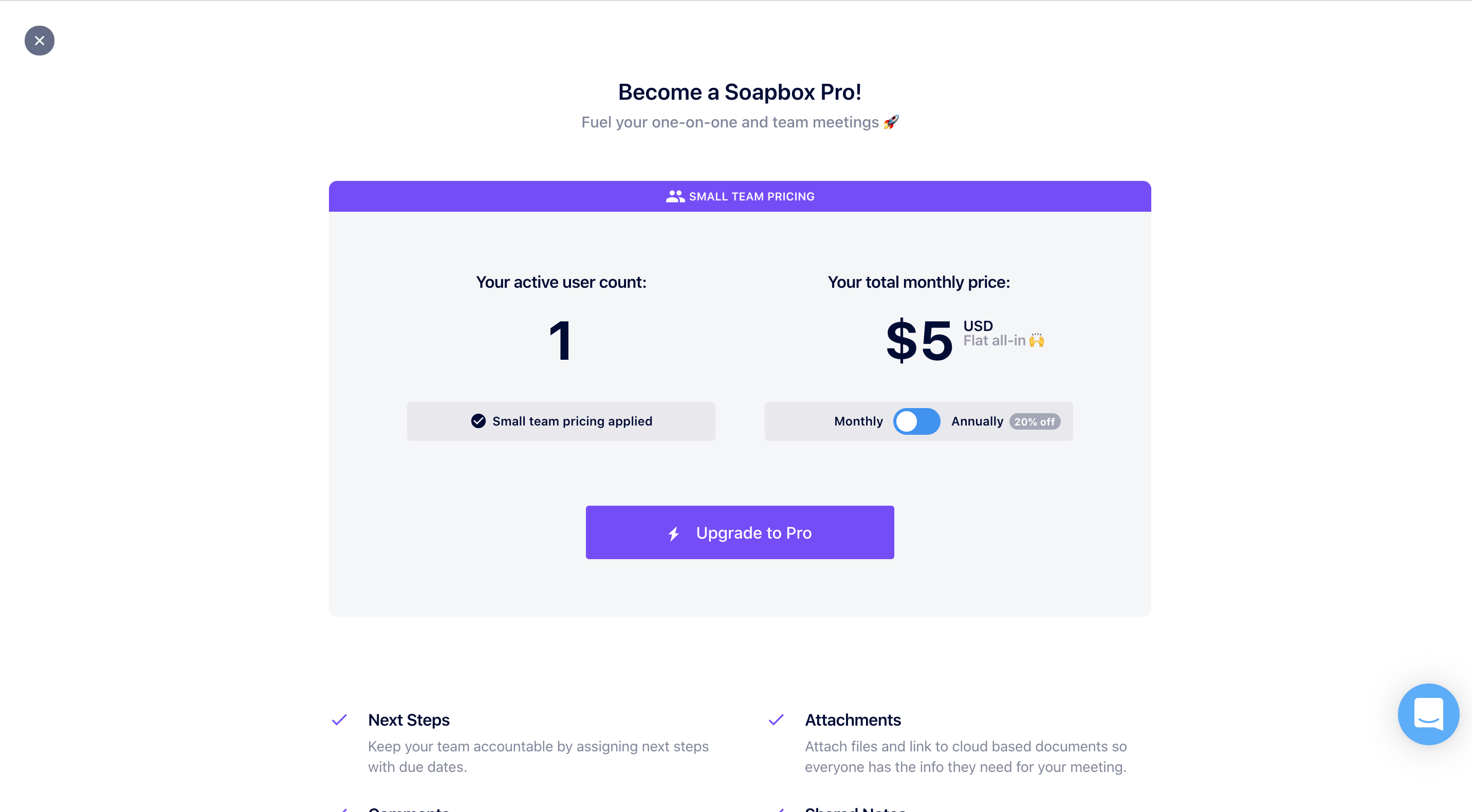
By far this has been the most effective way at generating more expansion MRR, from initial upgrades from free to Pro, as well as from Pro to Business.
This, combined with some of their other customer expansion revenue, keeps their expansion revenue at the same level or higher than new MRR each month. In fact, last month their expansion MRR was 1.3 times more than their new MRR, which is just more proof of the power of customer expansion.
Whether you go the route we went with the minimal notifications, Ahrefs with a banner, or locking upgraded features like ConvertKit, in-product upsells are a great way to boost your customer expansion revenue.
4. Use customer feedback to create new products (and cross-sell them)
This is probably the most ambitious way to boost your expansion MRR, but it can also yield the biggest results.
Create new add-on features or even an additional product that you can cross-sell to your existing customers.
Since there’s a ton of resources involved in order to pull off, you’re going to want to do plenty of research and be certain it’ll be worth it.
The brightside is it’s usually a little easier than creating your initial product since you already have a customer base to sell too.
Take this example from Nathan from Funnel Fix It for instance.
They started off with their initial service, and had success for years. However, a huge chunk of their clients were agencies, and Nathan noticed a lot of them struggled with billing and onboarding their own clients. And the ones who did have a solution were paying thousands of dollars for it.
So Nathan and his team built their own billing and onboarding platform tailored towards agencies, that would cost a fraction of what their clients were already paying elsewhere.
When they were ready to launch, they reached out to a small group of their existing customers who they knew could benefit from the platform. That allowed them to do a “soft launch” and work out the kinks before offering it to the rest of their customers.
Since launching the new tool, they’ve seen a 30% increase in their LTV, and their MRR has been trending in the right direction.

We also have first-hand experience with this tactic after launching Recover and Cancellation Insights. We offer both products as up-sells, and standalone tools.
And these two products have generated over $20K in MRR for us.

If you want to try this out yourself, here are some tips:
- Talk to your customers: If you want ideas for what type of add-ons or additional products to make, find out what your customers want. And if you already have an idea for what you want to make, ask your customers if they’d be willing to pay for it.
- Make it relevant to your product: This isn’t a 100% requirement, but it’ll make it a whole lot easier to upsell to your existing customers if your new product fits in with your existing one. This was one of the keys to the success of Recover and Cancellation Insights.
- Incentivize your current customers: When you first launch, give your existing customers an incentive to try it. It could be a discount, extended free trial or even early beta access. If you want, you can also create some type of bundle deal with your flagship product.
- Make it a standalone product: You don’t need to limit your new product to just existing customers. We allow new customers to sign up for just Recover or Cancellation Insights if they want. It won’t increase your expansion revenue, but the new customers will still boost your overall MRR.
5. Land and expand
With the land and expand strategy, you “land” customers in with a lower-cost introductory product, like a free trial or basic plan. Then over time as you build a relationship with them and help them grow, you’re able to “expand” the relationship through upgrades
This has been one of Kinsta’s main strategies for customer expansion, and their Chief Business Officer Tom Zsomborgi, shared how they’ve used it to grow.
Tom Zsomborgi
CBO @ Kinsta

Most of our expansion MRR comes from upgrades. A lot of our clients start with a lower plan. They just test the hosting service with a single site (usually agencies follow this path) or with a small site. Once they see the power of the platform and the quality of the service, they bring more sites over and move their main projects to us resulting in plan upgrades as they need more installs and other resources. We like the land and expand strategy. We are confident with our offering and we know that once we get clients onboard they are very likely to stay, upgrade and grow with us.
Email Meter uses a version of land and expand as well. Their Basic plan offers enough value to land initial users.
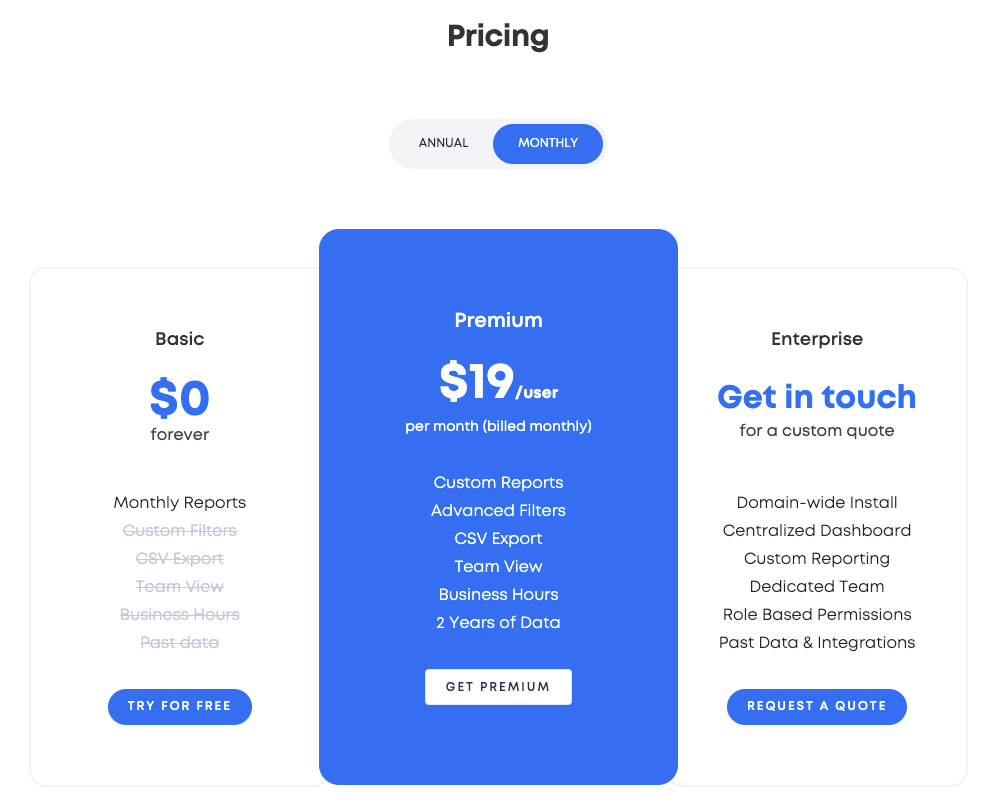
Then, as users have a chance to the product, they start adding additional users, want more advanced features or even need custom work.
According to Email Meter’s CEO, Marianella Mace, their most effective customer expansion strategy is building relationships with users through their Customer Success team.
Every customer that comes to you with a question is an opportunity to strengthen your relationship with them and show them other ways your product can create value for them. With this strategy, a little over 50% of Email Meter’s MRR comes from customer expansion.
Land and expand works particularly well for SaaS companies that offer “scalable” pricing. You want to offer a price level that’s low enough to bring in the entry level users, but also has room to scale up.
Using Kinsta as an example, their lowest priced plan is $30. That’s low enough to get entry level people in the door. And then as their needs change, they can expand to one of the higher priced plans.
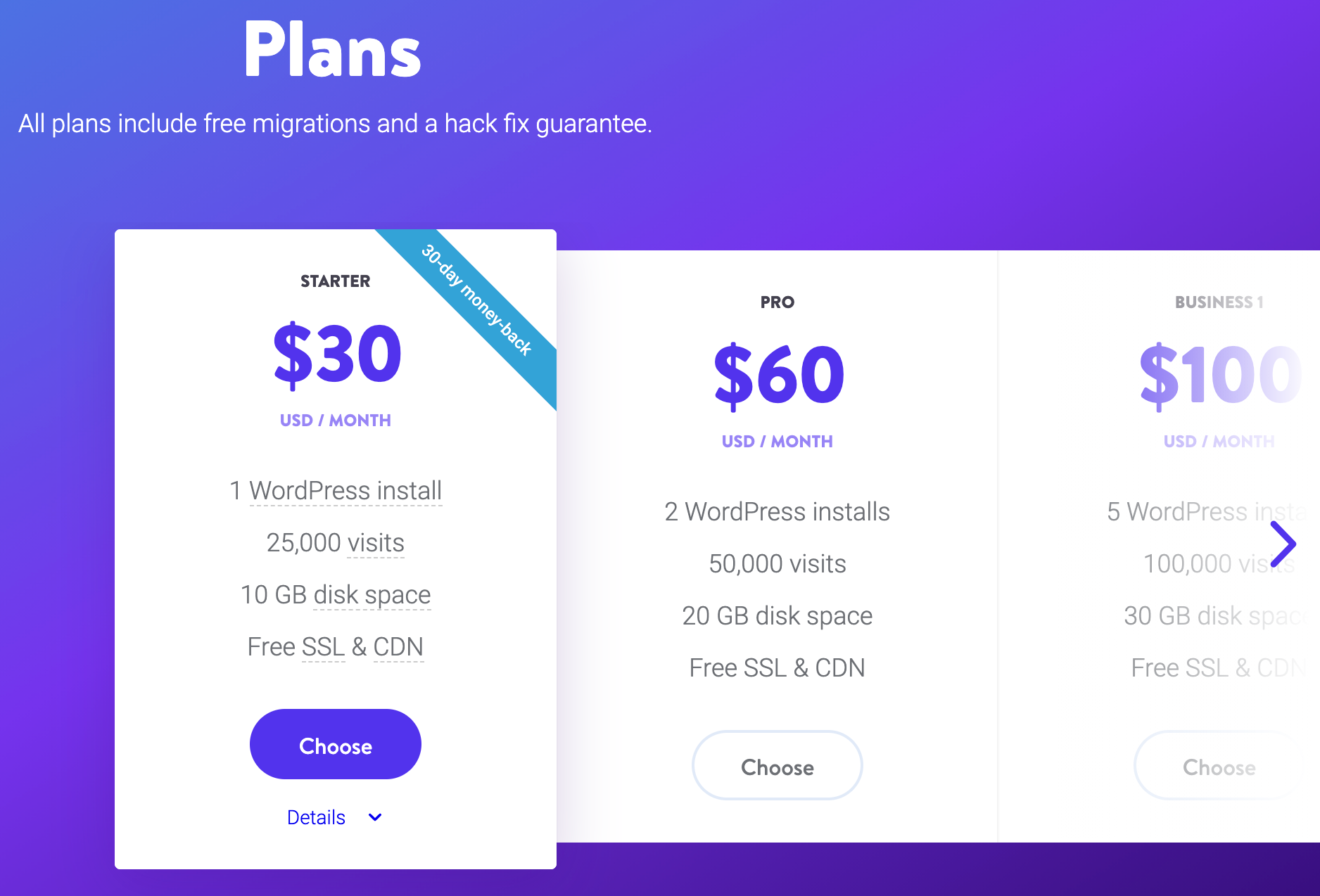
But let’s say if instead, their lowest priced plan was $100. The people who would’ve been willing to try the service at $30 (and would’ve eventually built up to the $100 plan) are automatically excluded and Kinsta would lose out on potential customers.
WP Buffs is another company that takes the land and expand approach. They offer WordPress website management for individual website owners, as well as agencies. The majority of their expansion MRR comes from their agency clients.
Here’s how it works.
Agencies use WP Buffs to manage their own client’s websites through a white label service. When one of their agency partners gets a new client, they add them to their white label account at WP Buffs, which = expansion MRR.
As a result, WP Buffs doubled down on their agency program by creating a ton of marketing resources their agency partners can use to get more clients.
Again, the takeaway here is with the land and expand strategy, the more effort you put towards making your customers successful, the more expansion revenue you’ll see.
As soon as you “land” a customer, start building and nurturing a relationship with them. Eventually, you’ll be able to expand that relationship into more MRR.
Is customer expansion the missing piece to your growth?
Instead of spending all your time thinking of ways to get new customers, think of how you can provide more value to your current ones.
Not only can customer expansion increase your MRR, but it also increases your customer lifetime value and reduces churn.

